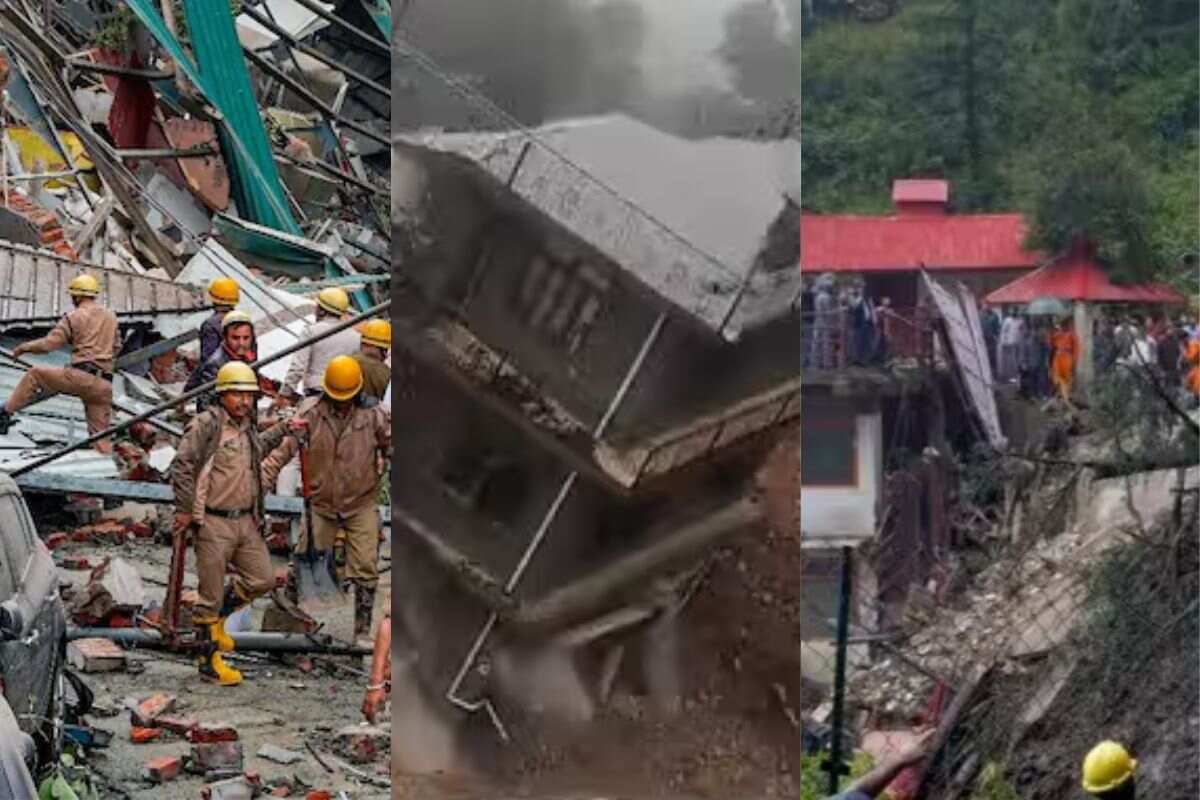
Nature is constantly signaling humans to change their ways, to be more mindful, and to be cautious. It warns us that interfering with nature can lead to destruction. The Kedarnath tragedy in 2013 and the Chamoli disaster in 2021 are just two examples of the destructive power of nature in Uttarakhand.
Once again, this warning is evident in Himachal Pradesh and Uttarakhand. Heavy rainfall, cloudbursts, and landslides have so far claimed the lives of more than 70 people and left thousands homeless. The Mandi-Kullu National Highway in Himachal Pradesh has been devastated by boulders falling from the mountains. A section of the Kalka-Shimla National Highway-5 and the Solan-Parwanu four-lane road have also collapsed, with debris reaching several houses.
Estimates suggest that the damage caused by the recent rains, floods, and landslides is worth 7,500 crores. It is difficult to say when and how the recovery from this damage will occur, but terrifying scenes are still being reported from remote areas. Those who are stranded are being rescued by the Indian Air Force’s helicopters. Every effort is being made to save every life.
The danger is not yet over. If we believe the meteorological department, both states may have to face the wrath of rain for the next week. The unusual weather changes are not only being seen in India but all over the world, and humans are entirely responsible for this.
The burden of tourism and tourists, climate change, melting glaciers, and excessive rainfall, in addition to roads being built on mountains, explosions used to break mountains, debris from roads and other infrastructure constructions falling into rivers, improper methods of mountain cutting, tunnel projects beneath the mountains, increasing population in hill towns, new styles of house construction in the mountains, and power plants, are all major factors that scientists believe are causing our mountains to bleed.
The sliding mountains
In Himachal Pradesh, the number of landslide incidents has increased sixfold in the past two years. According to data compiled by the State Disaster Management Department, there were 16 landslide incidents in Himachal Pradesh in 2020. This number increased to 100 in 2021 and further to 117 in 2022.
A survey by the Geological Survey of India found that 17,120 sites in Himachal Pradesh are affected by landslides. Of these, 675 sites are located near residential areas and critical infrastructure.
The Indian Space Research Organisation (ISRO) has found that all 12 districts of Himachal Pradesh, from Chamba to Kinnaur and Sirmaur, are located in the landslide-affected region.
The Fragile Himalayas
Experts believe that both hill states of Himachal Pradesh and Uttarakhand are geologically and environmentally weak and sensitive. The mountains of Himachal Pradesh and Uttarakhand are relatively young, having formed about 50 million years ago. The Western Ghats, on the other hand, are about 150 million years old. The Western Himalayas are made up of metamorphic rocks, which have been transformed by heat and pressure. These rocks are not as strong as the igneous and sedimentary rocks of the Western Ghats.
Deforestation- A cause of major worry
Another point is that dense forests on the mountains protect the soil and rocks. Disaster management experts believe that deforestation is a major cause of landslides. The roots of trees firmly grip the soil and also hold the stones of the mountains together. When forests are cut down, this grip is weakened. As a result, when it rains, rocks break away from the mountains and fall, leading to massive destruction.
During construction, the slopes of the mountains are often cut, and the debris falls into the river, obstructing its flow. This can cause the river to overflow and flood downstream areas. Cutting the mountain slopes also destabilizes the entire region, making it more prone to landslides.
Construct roads with care
Road construction has increased rapidly in Himachal Pradesh over the past 10 years. According to the data from the Ministry of Road Transport and Highways, in 2014, 2,196 kilometers (km) of national highways were constructed, which increased to 6,954 km by 2023.
Looking at the tunnel statistics from the Ministry of Road Transport and Highways for the mountains, 18 tunnels are functional in Uttarakhand, with plans to build 66 more, while in Himachal Pradesh, 1 tunnel is functional, and there are plans to construct 19 more.
Recently, the Supreme Court raised objections to widening the road for the Char Dham pilgrimage. The government justified the expansion citing national security, but indiscriminate tampering with the mountains in the name of development could prove costly.
Shimla- A wounded queen of hills
People are blaming nature for the devastation in Shimla, but the truth is that the destruction is being brought about in the name of development.
The weight on the ground is increasing due to the construction of houses. The British had settled Shimla for a population of 25,000, but today there are more than 230,000 houses. Nearly 90% of these houses are built on hills with a slope of 45 to 60 degrees. In many areas, houses are built on slopes of 70 to 75 degrees, even though the National Green Tribunal (NGT) has prohibited construction on slopes greater than 45 degrees. Despite this, permission has been granted to build houses in areas with more than 70% slope.
Mega Hydropower projects aren’t helping the situation
Hydropower projects are a major cause of devastation in the hills. Tunnels are blasted through mountains to build these projects, and the vibrations caused by heavy machinery can destabilize the slopes. Despite warnings, hydropower projects are being constructed in Joshimath at Pipalkoti and Vishnugadh. In Joshimath, the hydro power project has been held responsible for the land slippages.
Excessive tourism is not sustainable
Excessive tourism is also a major cause of devastation in the mountains. This is evident from the data from the last three years of Himachal Pradesh and Uttarakhand. In 2020, during the COVID-19 pandemic, Himachal Pradesh received nearly 22 lakh tourists. This number decreased to 19 lakh in 2021, but increased to 86 lakh in 2022. Uttarakhand saw a similar trend, with 78 lakh tourists in 2020, 2.8 crores in 2021, and 5.5 crores in 2022.
The increasing number of tourists has led to the construction of more hotels and guesthouses. In Manali, a popular tourist destination in Himachal Pradesh, there were only 10 hotels in 1980. By 2022, this number had increased to 2,500. Most of these hotels and guesthouses are built without any scientific planning.
The number of pilgrims coming to Uttarakhand for the Char Dham Yatra is also increasing. Helicopter tourism is also causing vibrations in the mountains, further weakening them.
The devastating consequences of global warming
Global warming is also a significant reason behind the natural upheavals in the mountains. Temperature experts for the Hindu Kush Himalayan region believe that the average temperature of the Himalayas is increasing faster than the temperatures in other parts of the country. A report by the Earth Science Department of the Indian government in 2020 stated that between 1951 and 2014, while the average temperature in the Hindu Kush Himalayas increased by 1.3 degrees, the increase in other parts of the country was 0.7 degrees Celsius.
Due to climate change, there have been reports of reduced snowfall and shrinking glaciers for several years. According to a report, there has been a 19 to 27 percent reduction in snowfall, which has impacted three major rivers of the Himalayas: Ravi, Beas, and Sutlej.
Another consequence of global warming is the floods resulting from glacier bursts. In Himachal Pradesh, there are about 958 glacial lakes of 500 square meters, out of which 109 have formed in recent years. The bursting of these lakes can lead to a flood scenario beyond imagination.
After studying the glaciers and lakes of Himachal, ISRO has warned that 935 glaciers and lakes are at risk of bursting. On February 7, 2021, the Chamoli tragedy in Uttarakhand was attributed to the rupture of a glacial lake.
In February 2022, NASA released a report suggesting that the Himalayan region might experience an increase in landslide incidents due to heavy rainfall along with climate change. With rising temperatures, there can be noticeable intensities in seasonal events here.
Himalayas are not alone in suffering
Unusual weather changes are being observed not only in India but all around the world. While some places are witnessing heavy rainfall and flooding, others are breaking temperature records. European countries are grappling with extreme heat. Norway is witnessing chaos due to flooding, while the Hawaiian islands in the USA are experiencing wildfires. Neither China nor America has been spared from nature’s wrath. The water levels of rivers and lakes in Norway are continuously rising due to the storm. China faced similarly devastating conditions a few days ago. The rise in temperature is being attributed to global warming, which has not only affected European countries but also several regions in the USA, where temperatures exceeded 50 degrees Celsius.
How to save the situation
It can be said that the situation across the globe is alarming. As per the Paris Agreement, the goal is to reduce the temperature by 1.5 degrees by the end of this century, but the situation still doesn’t seem to be under control. To prevent devastation on the mountains of Himachal and Uttarakhand, it is imperative to consider the following points:
- A complete halt to unnecessary construction in the name of development.
- Ban construction work that’s being carried out unscientifically.
- Assess the potential damage before constructing roads, bridges, dams, and power projects on the mountains.
- Strictly enforce restrictions on debris dumping into rivers.
- Curb over-tourism. It’s essential to regulate it, just as countries like Italy and Greece have done. For instance, in the Acropolis city in Greece, there’s a restriction on the entry of more than 20,000 tourists.
- Install early warning systems to predict destruction in the mountains.
- Strictly enforce restrictions on deforestation.
The way governments modify regulations in the name of development is also a major reason for causing harm to nature. The crux of the matter is that while development is essential, if it’s done at the risk of human lives, it’s tantamount to inviting destruction.



















